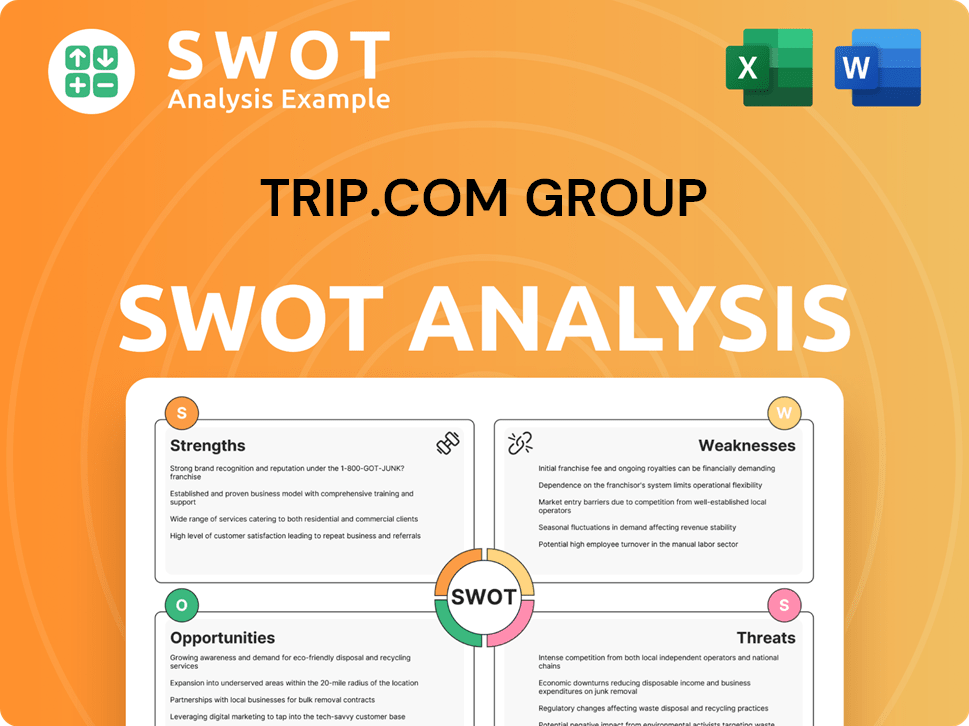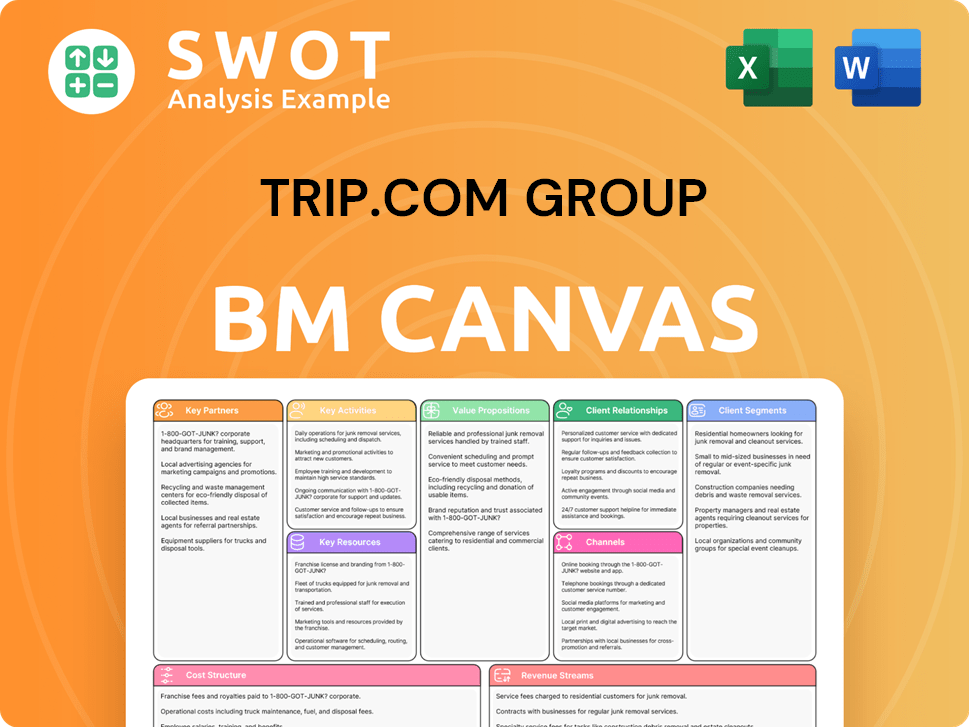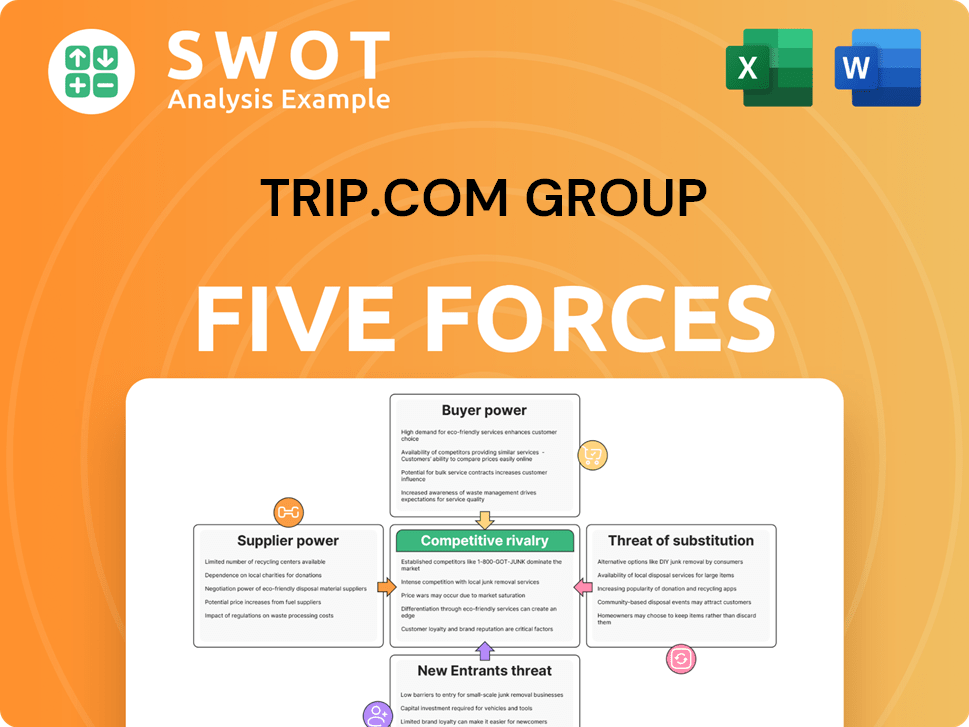Trip.com Group Bundle
How Does Trip.com Group Dominate the Travel Industry?
The online travel landscape is fiercely competitive, with giants constantly vying for market share. Trip.com Group, formerly Ctrip, has risen to become a global powerhouse. Understanding its position requires a deep dive into its rivals and its strategic moves.

From its origins in China to its global presence today, Trip.com Group's journey is a masterclass in adaptation and expansion. To truly grasp its influence, we must dissect its Trip.com Group SWOT Analysis, its competitive landscape, and the factors driving its success. This analysis will explore Trip.com's market position, examining its strengths, weaknesses, and the ever-evolving dynamics of the travel industry competition.
Where Does Trip.com Group’ Stand in the Current Market?
Trip.com Group holds a significant market position within the global online travel industry. Its core operations involve providing a comprehensive suite of travel-related services. These services include accommodation reservations, transportation ticketing, packaged tours, in-destination services, and corporate travel management. The company's value proposition centers on offering a one-stop platform for travelers, providing convenience, competitive pricing, and a wide range of options.
The company's market position is particularly strong in the Asian market, with a dominant presence in China. Its platforms cater to a diverse customer base, from budget travelers to premium clients. Trip.com Group has strategically expanded its reach globally, leveraging platforms like Trip.com and Skyscanner to serve a worldwide audience. The company has shown strong financial performance and resilience in the travel industry.
Trip.com Group's financial health is robust. For Q4 2023, the company reported a net income of RMB 1.3 billion (US$187 million). Accommodation reservation revenue increased by 131% year-on-year, and transportation ticketing revenue grew by 86% year-on-year in Q4 2023, indicating strong recovery and growth. The company's ability to maintain profitability and increase revenue demonstrates its strong market position and effective business strategies.
Trip.com Group has a strong presence in Asia, particularly in its home market, China. Its international reach is expanding through platforms like Trip.com and Skyscanner. Qunar primarily focuses on the Chinese market.
The company serves a broad spectrum of customers, from budget-conscious travelers to premium leisure and corporate clients. This diverse customer base supports the company's revenue streams. This approach allows the company to capture a large share of the market.
Trip.com Group offers a wide range of travel products, including accommodation reservations, transportation ticketing, packaged tours, and in-destination services. Corporate travel management is also a key offering. These diverse offerings contribute to the company's robust revenue streams.
Trip.com Group has evolved from a domestic focus to a global player. The company is diversifying its offerings and investing in technology to enhance user experience. This strategic shift supports its long-term growth and market share.
Trip.com Group's market position is strengthened by its strong financial performance and diverse product offerings. The company's strategic expansion and focus on technology are key to its continued success. The company's robust revenue growth demonstrates its resilience and strong market position.
- Dominant presence in the Asian market, particularly China.
- Strong financial performance, with significant revenue growth in accommodation and transportation.
- Strategic global expansion through platforms like Trip.com and Skyscanner.
- Diverse product offerings catering to various customer segments.
- Continuous investment in technology to improve user experience.
For more insights into the financial aspects of the company, consider reading about Owners & Shareholders of Trip.com Group. The company's ability to adapt and grow in the competitive online travel agencies (OTA) market is a key factor in its continued success. The company's strategic investments and localized services are strengthening its foothold in various regions.
Trip.com Group SWOT Analysis
- Complete SWOT Breakdown
- Fully Customizable
- Editable in Excel & Word
- Professional Formatting
- Investor-Ready Format

Who Are the Main Competitors Challenging Trip.com Group?
The Trip.com competitive landscape is characterized by intense competition across various segments of the global travel market. As a leading online travel agency (OTA), Trip.com Group faces both direct and indirect rivals. Understanding the Trip.com Group analysis is crucial for assessing its market position and strategic moves.
Trip.com market position is significantly influenced by its ability to compete with established players and adapt to evolving consumer preferences. The travel industry competition is fierce, requiring continuous innovation and strategic partnerships. The OTA market share dynamics are constantly shifting, making it imperative for Trip.com Group to maintain a strong competitive edge.
Trip.com Group operates in a highly competitive global travel market, facing both direct and indirect rivals across its various business segments. Its most significant direct competitors include other global online travel agencies such as Booking Holdings (which operates Booking.com, Agoda, Kayak, and Priceline) and Expedia Group (which includes Expedia, Hotels.com, Vrbo, and Travelocity). Booking Holdings, for instance, is a dominant force in accommodation bookings globally, leveraging its extensive network and strong brand recognition. Expedia Group competes strongly across flights, hotels, and vacation rentals, often engaging in aggressive marketing and loyalty programs.
Booking Holdings (Booking.com, Agoda, Kayak, Priceline) is a major competitor, especially in accommodation bookings. Expedia Group (Expedia, Hotels.com, Vrbo, Travelocity) also poses a significant challenge across flights, hotels, and vacation rentals.
In Asia, Trip.com Group faces competition from regional players and super-apps. Grab and Gojek in Southeast Asia offer travel services, leveraging their large user bases.
Metasearch engines like Google Flights and TripAdvisor aggregate travel information, directing users to booking sites. Direct bookings through airline and hotel websites also provide competition.
Intense price competition, especially in flights and accommodations, is a common feature. Strategic partnerships are crucial for gaining exclusive inventory and enhancing loyalty programs.
New players focusing on niche markets, such as sustainable travel, are emerging. Mergers and alliances within the industry impact distribution channels and pricing power.
Key strategies include price competitiveness, strategic partnerships, and expansion into niche markets. Adapting to changing consumer preferences and technological advancements is essential.
Trip.com Group's main competitors are Booking Holdings and Expedia Group, who are the main players. Understanding Trip.com Group's strengths and weaknesses is crucial for assessing its market position. Trip.com Group's financial performance in recent years has shown resilience, but the Trip.com Group's market share worldwide is constantly evolving.
- Price Competitiveness: Offering competitive pricing on flights, hotels, and other travel services.
- Customer Service: Providing excellent customer service to build loyalty and trust.
- Technology and Innovation: Investing in technology to improve the booking platform and user experience.
- Strategic Partnerships: Forming partnerships with airlines, hotels, and other travel providers.
- Marketing and Branding: Effective marketing campaigns to enhance brand recognition and attract customers.
Trip.com Group PESTLE Analysis
- Covers All 6 PESTLE Categories
- No Research Needed – Save Hours of Work
- Built by Experts, Trusted by Consultants
- Instant Download, Ready to Use
- 100% Editable, Fully Customizable

What Gives Trip.com Group a Competitive Edge Over Its Rivals?
The Growth Strategy of Trip.com Group hinges on several key competitive advantages that have solidified its position in the travel industry. These strengths include a robust technological infrastructure, extensive market reach, and a strong brand reputation. Furthermore, Trip.com Group's diversified service offerings, which range from flights and hotels to packaged tours, contribute to its competitive edge in the online travel agencies (OTA) market.
Trip.com Group's core competitive advantages are multi-faceted, stemming from its robust technological infrastructure, extensive market reach, strong brand recognition, and diversified service offerings. A significant advantage lies in its proprietary technology platform, which enables seamless booking experiences across various travel products and supports advanced data analytics for personalized recommendations and dynamic pricing. The company's investment in artificial intelligence and big data allows it to optimize search results, improve customer service, and enhance operational efficiencies.
The company's dominant market position in China provides it with a massive user base and strong relationships with local suppliers, leading to preferential inventory and pricing. This deep penetration into the Chinese market, combined with its global platforms, creates a powerful network effect. Its strong brand equity, built over two decades, fosters significant customer loyalty, evidenced by repeat bookings and high user engagement. The company's comprehensive service portfolio, encompassing everything from flights and hotels to packaged tours and corporate travel, offers a one-stop-shop solution for travelers, enhancing convenience and stickiness.
Trip.com Group invests heavily in its proprietary technology platform. This platform enables seamless booking experiences and supports advanced data analytics. The use of AI and big data optimizes search results and enhances customer service.
The company holds a dominant position in the Chinese market. This provides a massive user base and strong supplier relationships. These relationships translate into preferential inventory and pricing for its customers.
Trip.com Group has built strong brand equity over two decades. This fosters significant customer loyalty, leading to repeat bookings. High user engagement is a key indicator of its brand strength.
The company offers a comprehensive service portfolio. This includes flights, hotels, packaged tours, and corporate travel. This one-stop-shop solution enhances convenience and customer stickiness.
Trip.com Group's competitive advantages have evolved from a domestic focus to a global strategy. Acquisitions, such as Skyscanner, have significantly boosted its metasearch capabilities and international reach. These advantages are largely sustainable due to the significant investment required in technology, brand building, and establishing supplier relationships.
- Technological Innovation: Continuous investment in AI and data analytics to enhance user experience.
- Global Expansion: Strategic acquisitions and partnerships to broaden its geographic footprint.
- Customer-Centric Approach: Focus on personalized recommendations and excellent customer service.
- Strong Supplier Relationships: Leveraging partnerships to secure competitive pricing and inventory.
Trip.com Group Business Model Canvas
- Complete 9-Block Business Model Canvas
- Effortlessly Communicate Your Business Strategy
- Investor-Ready BMC Format
- 100% Editable and Customizable
- Clear and Structured Layout

What Industry Trends Are Reshaping Trip.com Group’s Competitive Landscape?
The online travel industry is experiencing significant shifts, with increased demand for personalized experiences, a growing emphasis on sustainable tourism, and the integration of AI and big data. Regulatory changes, particularly in data privacy and consumer protection, also play a crucial role in shaping the market. These trends present both challenges and opportunities for major players like Trip.com Group.
Understanding the Trip.com competitive landscape is crucial for investors and stakeholders. The company faces challenges from emerging technologies and new market entrants, while also benefiting from growth opportunities in developing economies and product innovations. This analysis provides a comprehensive look at the industry trends, future challenges, and opportunities impacting Trip.com Group.
The travel industry is being reshaped by several key trends. There's a growing demand for personalized travel experiences, fueled by advancements in AI and data analytics. Sustainable tourism is also gaining traction, as travelers become more conscious of environmental impacts. Furthermore, the integration of AI and big data continues to drive innovation in booking platforms and customer service.
Several challenges loom for online travel agencies. The emergence of Web3 technologies and the increasing influence of social commerce could disrupt traditional booking models. Economic downturns and increased regulatory scrutiny pose significant threats. Aggressive expansion by super-apps and direct booking channels from suppliers also intensifies competition.
Significant growth opportunities exist for companies like Trip.com Group. Emerging markets, particularly in Southeast Asia, offer substantial potential due to rising middle classes and increasing internet penetration. Product innovations, such as enhanced in-destination services and VR travel experiences, can drive expansion. Strategic partnerships are also key to strengthening market position.
To remain competitive, Trip.com Group is focusing on several key strategies. These include global expansion, technological innovation, and a strong commitment to customer service. The company is also investing in AI-driven personalization and expanding its sustainable travel options. Strategic partnerships are crucial for growth.
Trip.com Group's strategies are centered around global expansion, technological innovation, and customer service. The company actively targets emerging markets like Southeast Asia, where internet penetration and disposable incomes are rising. In 2023, the company's international revenue grew significantly, reflecting its focus on global markets. The company is also investing heavily in AI and data analytics to personalize travel experiences.
- Global Expansion: Focusing on high-growth markets, particularly in Asia-Pacific.
- Technological Innovation: Utilizing AI and data analytics for personalized recommendations and enhanced booking experiences.
- Strategic Partnerships: Collaborating with airlines, hotels, and local operators to broaden offerings.
- Sustainable Tourism: Integrating eco-friendly options to attract environmentally conscious travelers.
The Trip.com market position is influenced by several factors. The company's financial performance, including revenue growth and profitability, is a key indicator of its success. The company's ability to adapt to changing consumer preferences and technological advancements is also crucial. Furthermore, maintaining a strong brand reputation and providing excellent customer service are essential for long-term sustainability. For more context, you can read a Brief History of Trip.com Group.
Trip.com Group Porter's Five Forces Analysis
- Covers All 5 Competitive Forces in Detail
- Structured for Consultants, Students, and Founders
- 100% Editable in Microsoft Word & Excel
- Instant Digital Download – Use Immediately
- Compatible with Mac & PC – Fully Unlocked

Related Blogs
- What are Mission Vision & Core Values of Trip.com Group Company?
- What is Growth Strategy and Future Prospects of Trip.com Group Company?
- How Does Trip.com Group Company Work?
- What is Sales and Marketing Strategy of Trip.com Group Company?
- What is Brief History of Trip.com Group Company?
- Who Owns Trip.com Group Company?
- What is Customer Demographics and Target Market of Trip.com Group Company?
Disclaimer
All information, articles, and product details provided on this website are for general informational and educational purposes only. We do not claim any ownership over, nor do we intend to infringe upon, any trademarks, copyrights, logos, brand names, or other intellectual property mentioned or depicted on this site. Such intellectual property remains the property of its respective owners, and any references here are made solely for identification or informational purposes, without implying any affiliation, endorsement, or partnership.
We make no representations or warranties, express or implied, regarding the accuracy, completeness, or suitability of any content or products presented. Nothing on this website should be construed as legal, tax, investment, financial, medical, or other professional advice. In addition, no part of this site—including articles or product references—constitutes a solicitation, recommendation, endorsement, advertisement, or offer to buy or sell any securities, franchises, or other financial instruments, particularly in jurisdictions where such activity would be unlawful.
All content is of a general nature and may not address the specific circumstances of any individual or entity. It is not a substitute for professional advice or services. Any actions you take based on the information provided here are strictly at your own risk. You accept full responsibility for any decisions or outcomes arising from your use of this website and agree to release us from any liability in connection with your use of, or reliance upon, the content or products found herein.